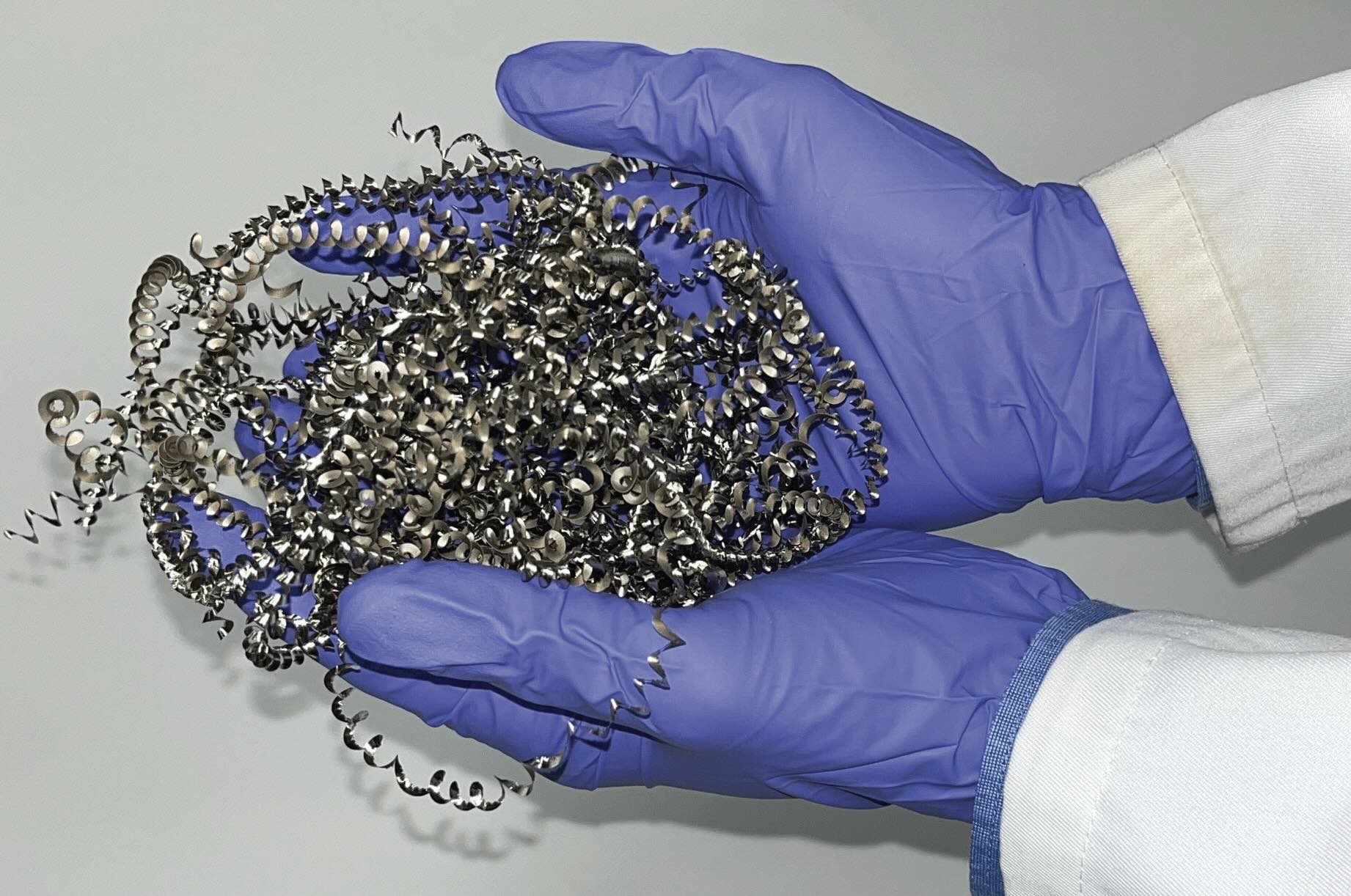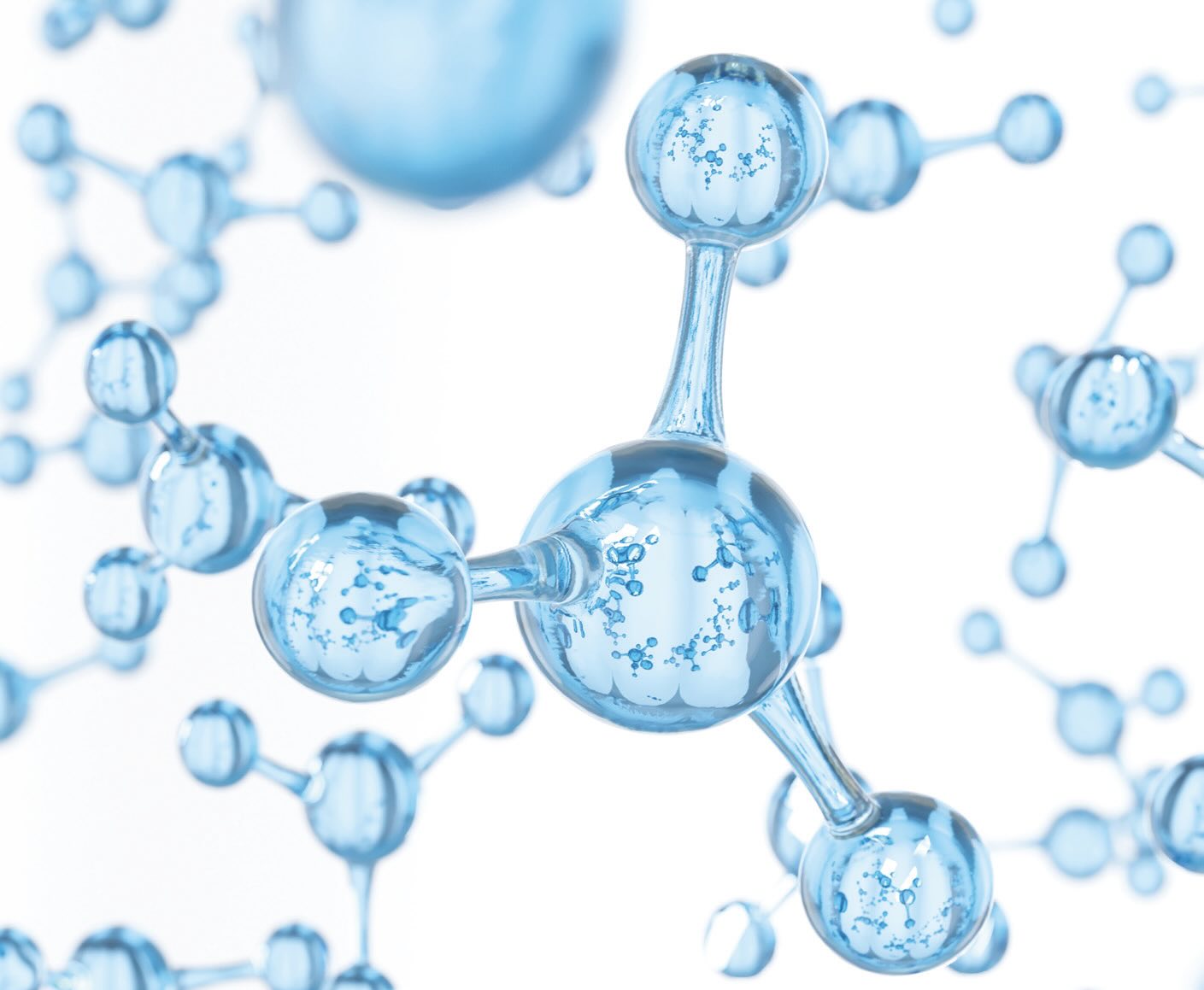HIGHLIGHTS
•
Metal chips derived from titanium, nickel and stainless steel alloys exhibit nanotextured surfaces making them suitable as electrocatalysts in the splitting of water.
•
Introducing two known metal catalysts, platinum and cobalt, to the titanium and the nickel alloy, Inconel 625, improved the performance of the hydrogen evolution and oxygen evolution reactions.
•
Using both of these catalysts in a full-cell electrolyzer produced a water splitting reaction efficiency of 100% at room temperature.
The transition to decarbonization can only succeed by finding more efficient procedures for synthesizing hydrogen from renewable energy sources. This means that identifying catalysts that can split water into oxygen and green hydrogen is required.
Synthesis of green hydrogen is very challenging due to the high cost of metal catalysts such as platinum, and as noted in a previous TLT article,
1 nine metric tons of water are required to produce one metric ton of hydrogen. This same article discusses research conducted to produce hydrogen from waste plastic using a technique known as flash joule heating. Initial work was done with high-density polyethylene, which was converted to hydrogen and graphene after being compressed in a quartz tube carbon black. The next set of experiments were carried out with waste plastic streams. Hydrogen was produced at yields ranging from 52%-68%, and the researchers claim that approximately 33%-95% less energy and 65%-89% lower greenhouse gas emissions are realized compared to other waste plastic or biomass destruction methods.
A different waste stream, metal chips, is prepared from classic metalworking operations. By taking a piece of metal that can be derived from steel, aluminum, copper, etc., metal removal operations such as drilling and tapping produce metal chips of various sizes and shapes depending upon the process.
Figure 1 shows an example of the metal chips formed.
 Figure 1. Metal chips produced from classic metalworking operations have been found to be suitable catalysts for splitting water into hydrogen and oxygen. Figure courtesy of the University of Nottingham.
Figure 1. Metal chips produced from classic metalworking operations have been found to be suitable catalysts for splitting water into hydrogen and oxygen. Figure courtesy of the University of Nottingham.
Typically, metal chips will be removed in a manufacturing plant by a flume system that utilizes a metalworking fluid. The metal chips can then eventually be recycled.
Andrei Khlobystov, professor of nanomaterials in the school of chemistry at the University of Nottingham in Nottingham, UK, says, “We have been evaluating options for catalyzing the splitting of water and decided to evaluate metal chips generated by an aerospace manufacturer at a production facility near our lab. The metal chips are composed of the titanium alloy, Ti-6Al-4V, two nickel alloys (Inconel 625 and 718) and the stainless steel alloy, 304L.”
The titanium alloy chips were sourced from a lathe operation that required the use of a metalworking fluid. Chips derived from the two Inconel alloys were obtained from industrial wastes while stainless steel alloy 304 chips were produced during a dry turning operation. All chips were rigorously cleaned in water, acetone and isopropanol prior to evaluation.
The metal chips may seem on first impression to have smooth surfaces making them impractical for use in catalysis. But Khlobystov and his colleagues decided to examine the surface using scanning electron microscopy. He says, “After analyzing the surface at the nanoscale, we found interesting topography features characterized by hills and valleys that were only tens of nanometers wide. These nanotextured surfaces are similar in composition to the nanocarbon materials such as carbon nanotubes that we have been working with over the past 20 years.”
Khlobystov and his colleagues recognized that this nanostructure may enable these metal chips to be suitable as electrocatalysts because they are good electric conductors. They initiated a research program to evaluate metal chips as catalysts in the splitting of water.
Modification of the metal chips
The metal chips were used as electrocatalyst candidates in both the hydrogen evolution (HER) and oxygen evolution (OER) reactions that spilt water. Initial evaluations were done directly on the four metal alloys that were processed into electrodes in one molar potassium hydroxide solution under an argon atmosphere.
Khlobystov says, “The stainless steel alloy exhibits the best performance in catalyzing the HER reaction followed by the nickel and titanium alloys. Stable metal hydride bonds formed with nickel and titanium led to surface poisoning reducing the effectiveness of both of those metal electrocatalysts. Due to the formation of nickel (III) hydroxide, the two nickel alloys demonstrated superior performance in the OER reaction compared to the other two metal alloys.”

To improve the effectiveness of the metal chips, the researchers introduced the known metal catalysts, platinum and cobalt, to modify the metal chips electrodes by magnetron sputtering in a vacuum. Khlobystov says, “We found loading 28 micrograms per square centimeter of platinum on titanium chips achieved exceptional HER performance. This places platinum nanoparticles with average diameters ranging from five to 20 nanometers in the grooves of the titanium chips. Excellent OER performance was demonstrated by loading 30 micrograms per square centimeter of cobalt on Inconel 625 due to the formation of interlinked flakes of cobalt hydroxide particles with average diameters of 100 nanometers.”
Putting both of these electrodes together into a full-cell electrolyzer led to a current density of 40 milliamps per square centimeter at 1.6 Volts versus a reversible hydrogen electrode. The rate of hydrogen and oxygen generated was 22.09 and 10.74 millimoles per minute. Khlobystov says, “We demonstrated that modifying metal chips with common catalysts led to a water splitting reaction efficiency of 100% at room temperature. The catalysts have proven to be durable, and the results are reproducible.”
A significant feature of this study is that the electrocatalysis was accomplished using approximately 10% of the platinum typically required in a state-of-the-art commercial catalyst. The researchers discovered that Inconel 625 acted as a better catalyst than Inconel 718. Khlobystov says, “We will need to do additional research to better understand the difference in electrocatalyst activity between the two nickel alloys.”
Future work also will involve scaling up the process using a 150 W electrolyzer to better understand the potential for commercialization. In addition, the researchers will be evaluating metal chips generated from other sources to determine if a similar catalytic effect is observed.
Additional information can be found in a recent article
2 or by contacting Khlobystov at
Andrei.Khlobystov@nottingam.ac.uk.
REFERENCES
1.
Canter, N. (2023), “Production of hydrogen and graphene from waste plastic,” TLT,
79 (12), pp. 18-19. Available
here.
2.
Thangamuthu, M., Kohlrausch, E., Li, M., Speidel, A., Clare, A., Plummer, R., Geary, P., Murray, J., Khlobystov, A. and Fernandes, J. (2024), “From scrap metal to highly efficient electrodes: harnessing the nano-textured surface of swarf for effective utilization of Pt and Co for hydrogen production,”
Journal of Material Chemistry A, https://doi.org/10.1039/D4TA00711E.